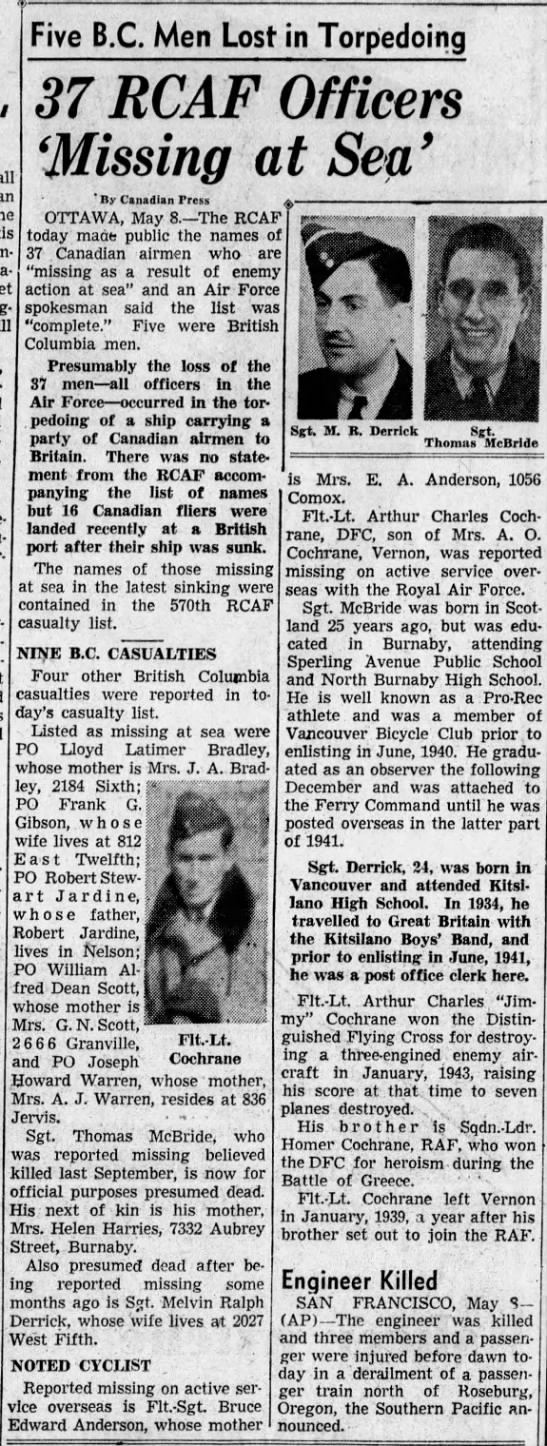
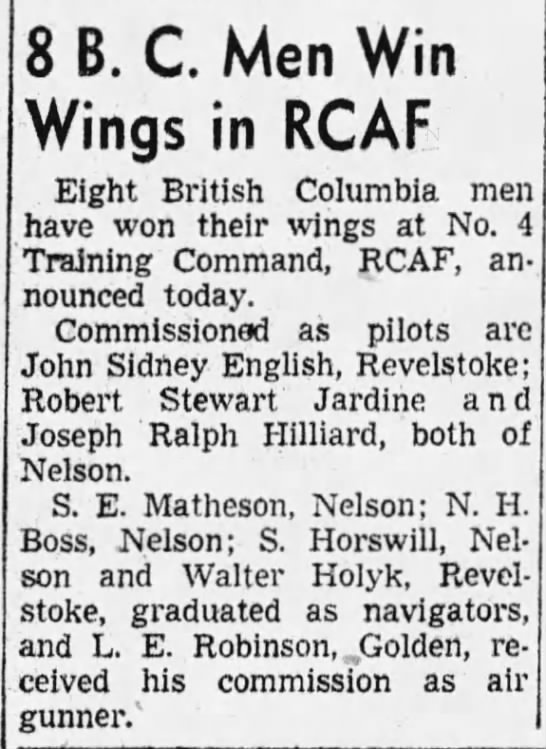
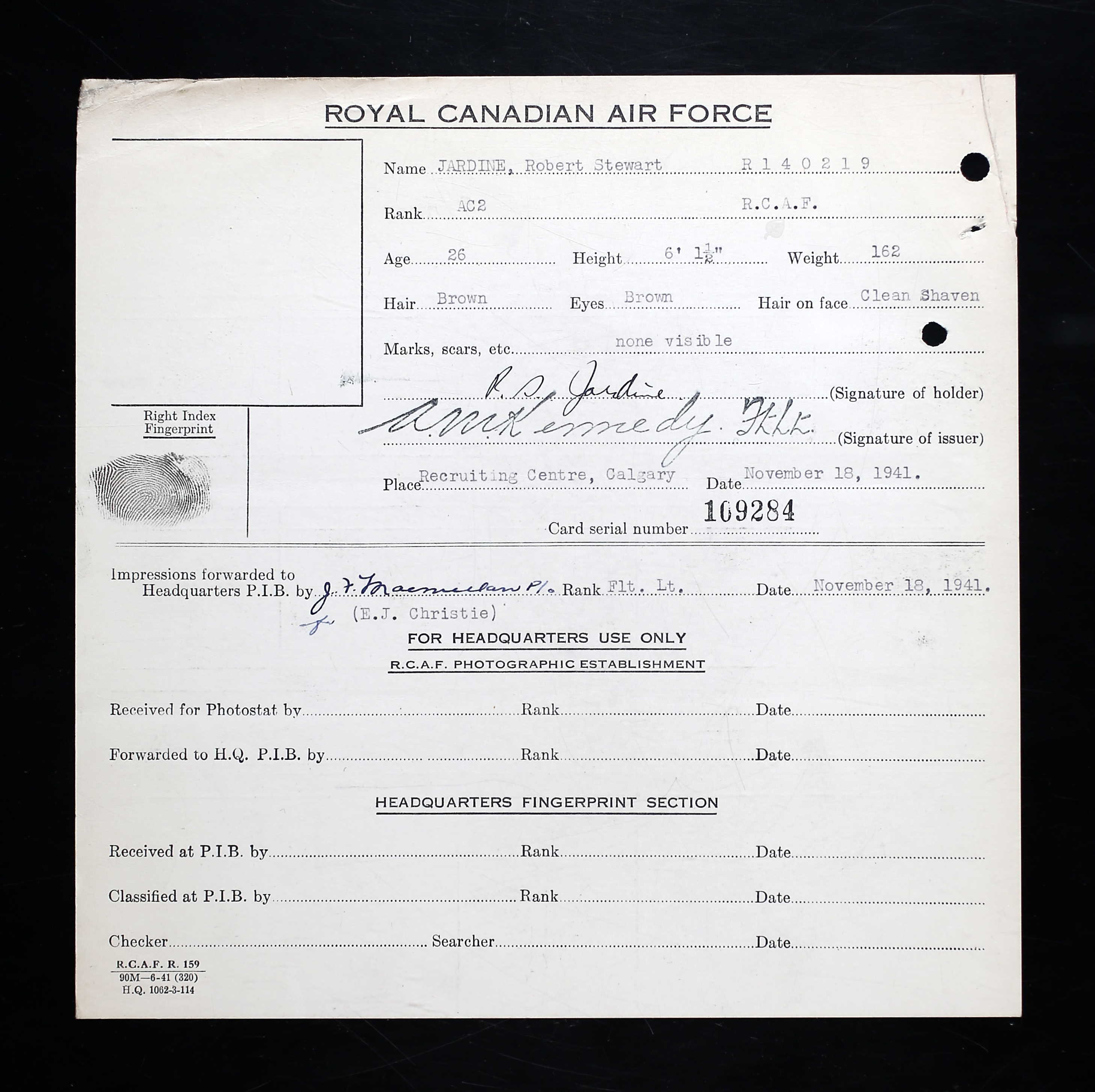
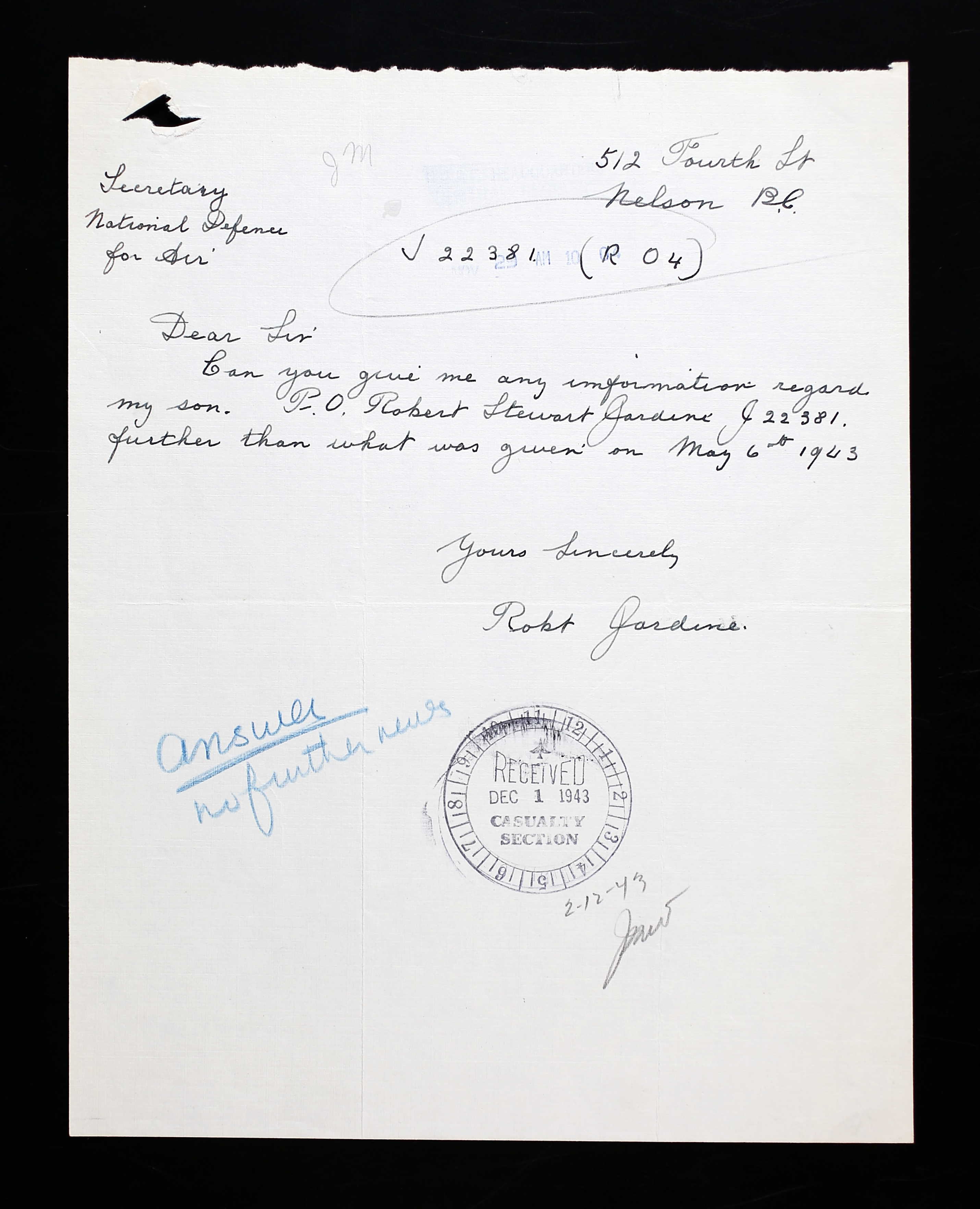
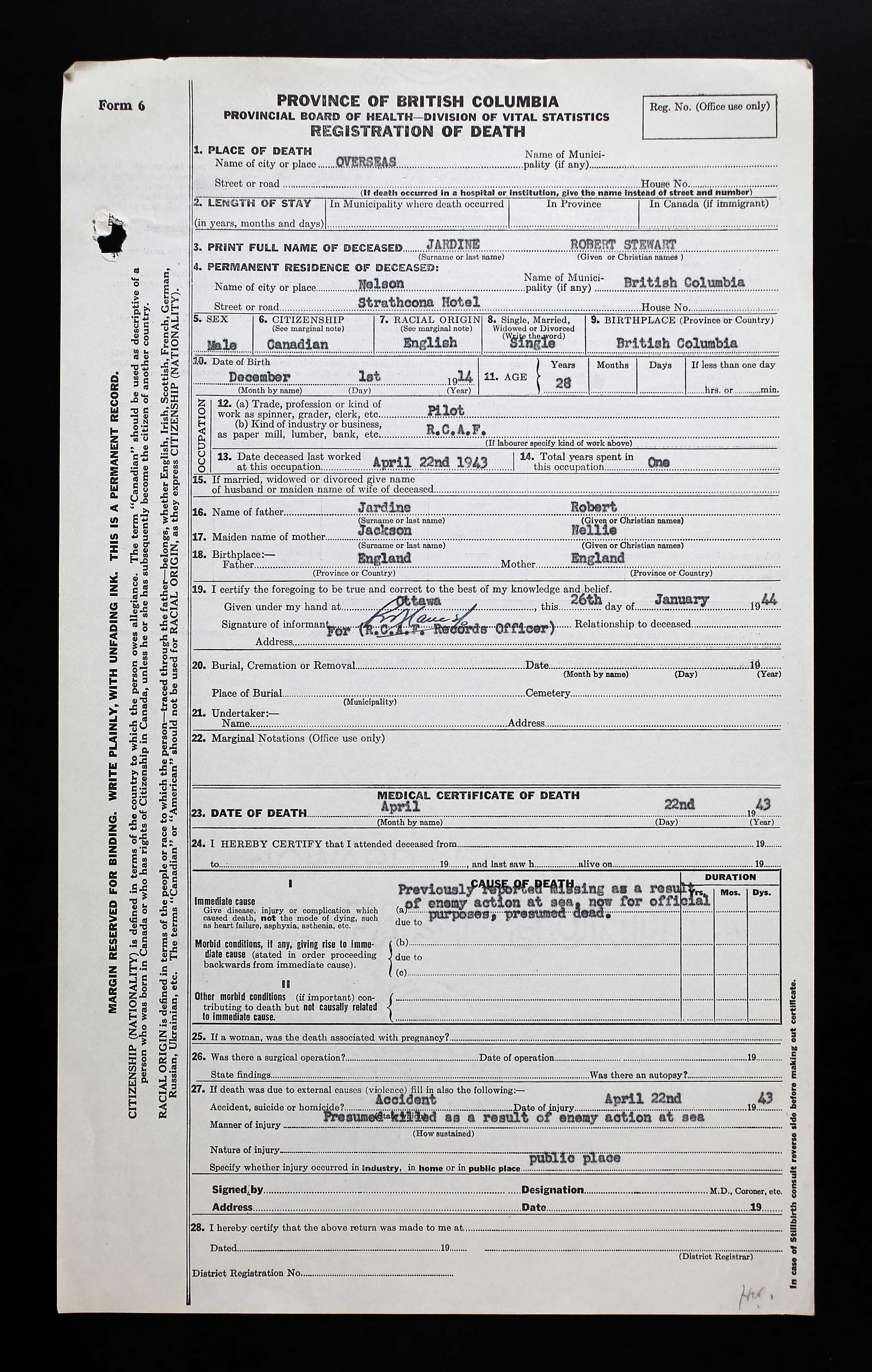
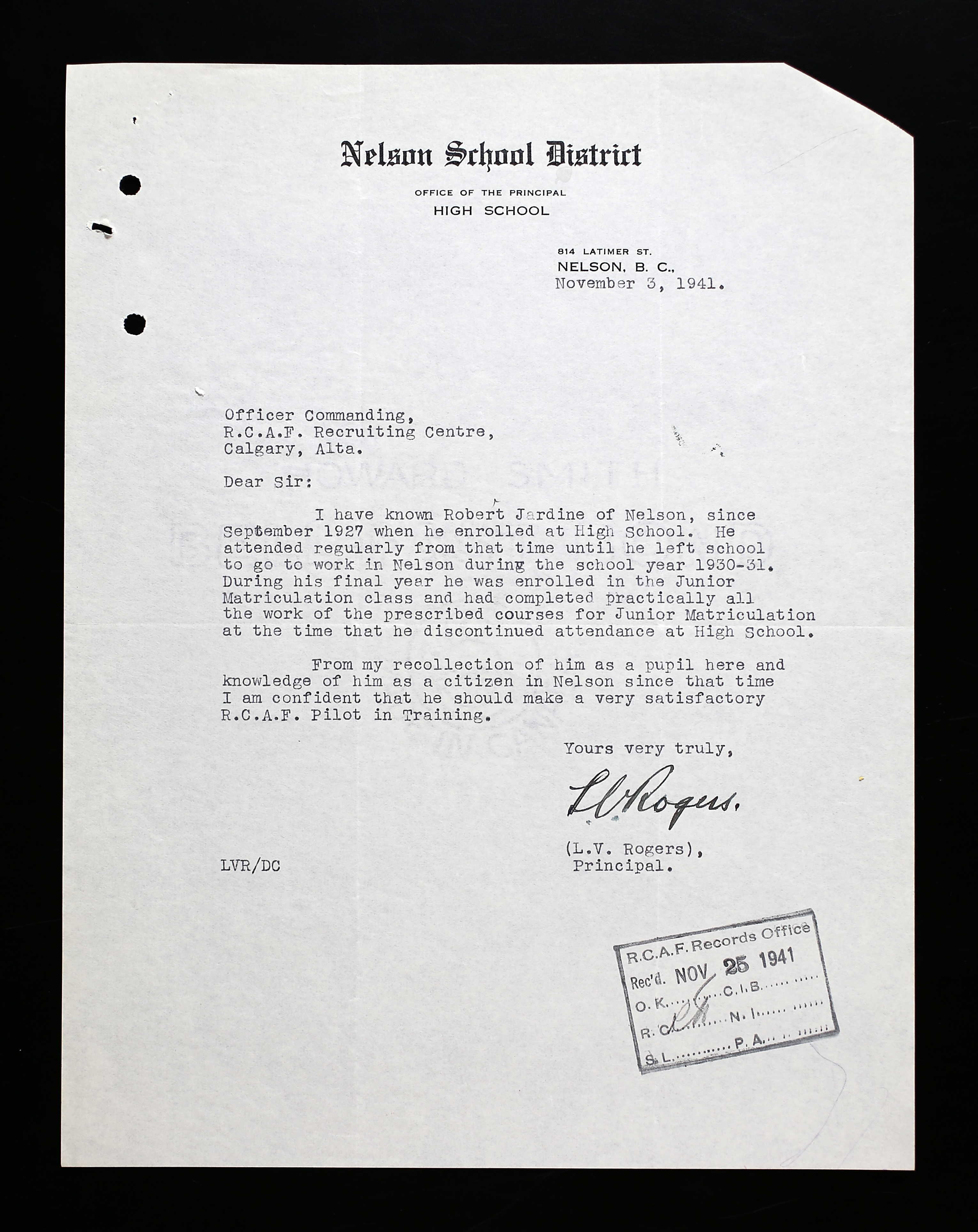
December 1, 1914 - April 22, 1943






Robert Stewart Jardine was the son of Robert, a carpenter, and Nellie (nee Jackson) Jardin of 508 Fourth Street, Nelson, BC. He had one sister, Winnifred Nellie Linville, living in Trail, BC. The family attended the United Church.
He enlisted with the RCAF in Calgary, Alberta on November 18, 1941. Prior to enlistment, he was a tinsmith apprentice (1931-1932), a labourer (1932-1933), did some farming and odd jobs for two more years, then was a linotype operator from 1935-1941. After the war, he wanted to return to the printing business.
Robert stood 6’ 1 ½” tall, weighed 162 pounds, had brown hair, brown eyes, and was clean-shaven. He enjoyed lacrosse, swimming, and skating.
Robert was sent to No. 2 ITS, Regina, Saskatchewan, Course 51 from April 12, 1942 to June 5, 1942. He earned 87.4% and was 26th out of 145 students. “One of the most popular airmen in the flight. He worked very hard on all subjects, but always found time to be of assistance to others. He is most keen to be a pilot and working very hard to realize his ambition. He is a very likeable type and extremely cooperative. He is dependable and serious about the service. He is recommended for a commission.”
From there, he was sent to No. 19 EFTS, Virden, Manitoba, Course 60, from July 20, 1942 to September 11, 1942, flying the Tiger Moth. He earned 86.28%, was 4th out of 32 students. “Has good sound judgment, no outstanding flying faults and is a hard worker. A little slow to think. Exceptional student in ground school. This pupil has great capacity for work and detail -- promising. Discipline and deportment good.”
As part of Course 64, Robert found himself at No. 11 SFTS, Yorkton, Saskatchewan, from September 14, 1942 to December 30, 1942 flying the Crane. He earned 82.9% and was 19th out of 61 students. “A very sound average student, who is cool, collected and reliable. Recommend for a commission.” Robert earned his Pilot’s Flying Badge on December 30, 1942.
Robert was then sent to No. 1 GRS, Summerside, PEI from January 23, 1943 until April 10, 1943. He received his commission while at this station.
On April 11, 1943, he was in Halifax awaiting to be transported overseas. He was attached to the RAF Trainees’ Pool on the 13th of that month.
On April 22, 1943, Robert was aboard the Amerika, part of convoy HX-234. It was straggling behind and a German U-boat south of Greenland torpedoed the ship. Thirty-seven men, all officers in the RCAF, were presumed missing as a result of enemy action at sea; sixteen were landed at a British port after their ship was sunk by U-306, south of Cape Farewell, off Greenland. Forty-two crew members and seven gunners were also amongst those who were lost. The master, Christian Nielsen, 29 crewmembers, eight gunners, and sixteen passengers were picked up by the HMS Asphodel, and landed at Greenock. General cargo, including metal, flour, meat and 200 bags of mail were also lost.
Found in other men’s files was a letter from dated June 1943 from F/L W. R. Gunn, RCAF Casualties Officer for Chief of the Air Staff. Mr. and Mrs. Jardine would most likely have received it as well. "Since my letter of May 6th, no additional news has been received. Attached is a list of the names and next-of-kin of sixteen Royal Canadian Air Force officers who embarked on the same ship as your son and following enemy action at sea were safely landed in the United Kingdom. The following official statement was made in the House of Commons....’I have been in receipt of communications from a number of members of this house and from people outside with reference to rumours regarding the recent loss of a number of members of the RCAF by the sinking of a ship in the north Atlantic and I desire to make the following statement on the facts. The vessel in question was a ship of British registry of 8,862 tons, designed for peace-time carriage of both passengers and freight, and having a speed of fifteen knots. She carried a crew of 86 and the passenger accommodation consisted of 12 two-berth rooms with bath and 29 other berths, providing cabin accommodations for 53 passengers. She was fitted with lifeboat capacity for 231 and travelled in naval convoy. Under the recently revised regulations agreed to by the United States authorities, the joint United Kingdom and United States shipping board, the Admiralty, the Air Ministry and the Canadian authorities, a vessel of this description travelling in convoy is permitted to embark as crew and passengers a maximum of 75% of the lifeboat capacity. The lifeboat capacity as stated above was 231, 75% of which is 173. Personnel on board consisted of the crew of 86, and RCAF personnel numbering 53, a total of 139, well within the prescribed limits. Because of the superior type of available passenger accommodation, the speed of the ship and the provision of naval convoy, the offer of the entire available space to the RCAF was immediately accepted. Rumours to the effect that this was a slow freighter not suitable for passenger accommodation are, of course, not in accord with the facts. Every precaution was taken to safeguard the lives of these gallant young men. It should be pointed out that on account of the serious shipping shortage every available berth on such ships must be used, and had the space not been taken up by the RCAF officers of the other arms of the services would have been placed on Board. It should also be stated again that the submarine is still the enemy’s most powerful weapon and that the Battle of the Atlantic is not yet won. Any ocean trip today in any part of the world is fraught with danger and I think I may safely say that our record in transporting our soldiers and airmen to the United Kingdom is one of while we may all be proud. No one deplores more than I do the loss of 37 of the finest of our young men who gave their lives for their country as surely as if they had done so in actual combat with the enemy, and I extend my deepest sympathy to their loved ones in their bereavement.’ If further information becomes available, you are to be reassured it will be communicated to you at once. May I again extend to you my sincere sympathy in this time of great anxiety."
The Secretary of National Defence for Air received a letter written in November 1943 by Mr. Jardine. “Can you give me any information regarding my son, P/O Robert Stewart Jardine, J22381, further than was given on May 6th, 1943?”
In blue pencil, “Answer: No further news.”
Mr. Jardine wrote another letter, dated December 14, 1943. "Thanks for the sympathy, but we would like to know more of the circumstances, name of vessel and if it was really torpedoed, as from information I have obtained. It happened in a snowstorm in early evening and visibility would be bad, under those conditions, as I have had experience in the North Atlantic and I just think for a sub to get so close, it would have been detected. I would like more information on this."
Mrs. Jardine received a letter in late October 1955 informing her that since Robert had no known grave, his name would appear on the Ottawa Memorial.